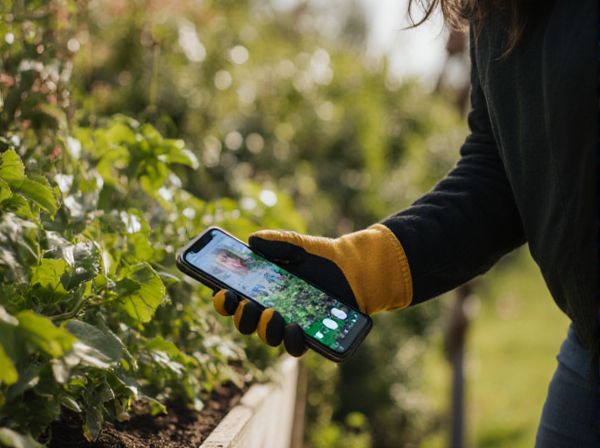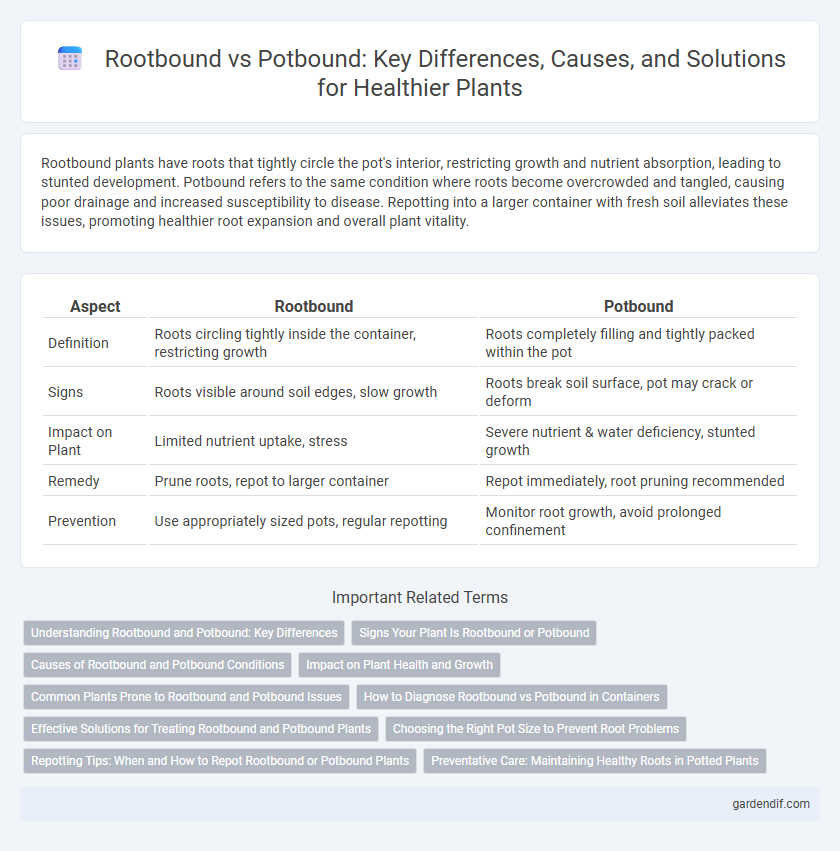
Rootbound vs Potbound Illustration
Rootbound plants have roots that tightly circle the pot's interior, restricting growth and nutrient absorption, leading to stunted development. Potbound refers to the same condition where roots become overcrowded and tangled, causing poor drainage and increased susceptibility to disease. Repotting into a larger container with fresh soil alleviates these issues, promoting healthier root expansion and overall plant vitality.
Table of Comparison
| Aspect | Rootbound | Potbound |
|---|---|---|
| Definition | Roots circling tightly inside the container, restricting growth | Roots completely filling and tightly packed within the pot |
| Signs | Roots visible around soil edges, slow growth | Roots break soil surface, pot may crack or deform |
| Impact on Plant | Limited nutrient uptake, stress | Severe nutrient & water deficiency, stunted growth |
| Remedy | Prune roots, repot to larger container | Repot immediately, root pruning recommended |
| Prevention | Use appropriately sized pots, regular repotting | Monitor root growth, avoid prolonged confinement |
Understanding Rootbound and Potbound: Key Differences
Rootbound plants have roots that densely circle and fill the pot, restricting growth and nutrient uptake, leading to stunted development. Potbound refers to plants confined in containers too small for their root systems, causing roots to become tightly packed and tangled, which impedes water absorption and air circulation. Recognizing these conditions is crucial for repotting decisions, ensuring healthy root expansion and overall plant vitality.
Signs Your Plant Is Rootbound or Potbound
Signs your plant is rootbound or potbound include roots growing through drainage holes, circling tightly around the pot's interior, and visible root mats on the soil surface. Wilting, stunted growth, and soil that dries out rapidly despite regular watering also indicate restricted root space. These symptoms reflect the plant's desperation for more room to expand, signaling it's time for repotting.
Causes of Rootbound and Potbound Conditions
Rootbound conditions occur when a plant's roots outgrow its container, causing the roots to circle tightly and become densely packed due to limited soil space and nutrient depletion. Potbound plants exhibit similar symptoms but often result from prolonged growth in undersized pots without repotting, leading to root constriction and reduced water absorption. Both conditions commonly arise from inadequate pot size, lack of root pruning, and insufficient soil volume to support healthy root expansion.
Impact on Plant Health and Growth
Rootbound plants exhibit tightly packed roots circling the pot, restricting nutrient and water absorption, which leads to stunted growth and nutrient deficiencies. Potbound plants face similar root congestion but may experience less severe symptoms if roots have room to expand and soil quality is maintained. Both conditions impact plant health by reducing oxygen availability to roots, causing stress that hampers overall development and increases susceptibility to diseases.
Common Plants Prone to Rootbound and Potbound Issues
Common plants prone to rootbound and potbound issues include spider plants, pothos, and peace lilies, which often outgrow their containers quickly due to vigorous root growth. Succulents such as jade plants and aloe vera frequently experience potbound conditions, causing restricted root space and stunted growth. Regular monitoring and repotting of these plants prevent root crowding, ensuring healthy nutrient absorption and optimal development.
How to Diagnose Rootbound vs Potbound in Containers
Diagnosing rootbound versus potbound plants involves closely inspecting the root system inside the container; rootbound plants exhibit densely packed roots circling the pot's interior, often strangling themselves and restricting growth. Potbound plants may have roots filling the pot but not aggressively circling or strangling the root ball, with some space remaining for soil and water retention. Checking for signs such as slowed growth, yellowing leaves, and roots emerging from drainage holes can confirm rootbound or potbound conditions, guiding timely repotting decisions.
Effective Solutions for Treating Rootbound and Potbound Plants
Effective solutions for treating rootbound and potbound plants include carefully loosening the tangled roots to promote healthy growth and repotting into a larger container with fresh, nutrient-rich soil. Pruning the roots can also help stimulate new root development, avoiding poor drainage and nutrient deficiencies caused by overcrowded root systems. Consistent watering and fertilizing after repotting ensure the plant recovers quickly and thrives in its expanded environment.
Choosing the Right Pot Size to Prevent Root Problems
Choosing the right pot size prevents rootbound issues where roots tightly circle the pot's edges, limiting growth and nutrient absorption. A slightly larger pot allows roots to expand without becoming potbound, which causes stunted growth and poor water retention. Monitoring root development and repotting when roots reach the pot's edge ensures healthy plant growth and optimal soil aeration.
Repotting Tips: When and How to Repot Rootbound or Potbound Plants
Repotting rootbound or potbound plants is essential when roots circle densely around the pot or emerge from drainage holes, indicating restricted growth. Choose a container one or two sizes larger with fresh, well-draining soil to encourage root expansion and nutrient uptake. Gently loosen tangled roots before planting to improve aeration and prevent future root circling, promoting healthier plant development.
Preventative Care: Maintaining Healthy Roots in Potted Plants
Maintaining healthy roots in potted plants requires timely repotting to prevent rootbound conditions, where roots circle tightly and restrict nutrient uptake. Ensuring adequate pot size and using well-draining soil enhances root aeration and prevents potbound stress that can stunt plant growth. Regularly inspecting root health and pruning excessively tangled roots supports vigorous development and overall plant vitality.
Rootbound vs Potbound Infographic

 gardendif.com
gardendif.com